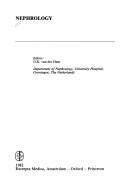| Listing 1 - 10 of 1023 | << page >> |
Sort by
|
Periodical
ISSN: 29536448
Abstract | Keywords | Export | Availability | Bookmark
 Loading...
Loading...Choose an application
- Reference Manager
- EndNote
- RefWorks (Direct export to RefWorks)
Periodical
Abstract | Keywords | Export | Availability | Bookmark
 Loading...
Loading...Choose an application
- Reference Manager
- EndNote
- RefWorks (Direct export to RefWorks)
Book
ISBN: 3642282369 Year: 2014 Publisher: Berlin, Heidelberg : Springer Berlin Heidelberg : Imprint: Springer,
Abstract | Keywords | Export | Availability | Bookmark
 Loading...
Loading...Choose an application
- Reference Manager
- EndNote
- RefWorks (Direct export to RefWorks)
Der Blick aufs Ganze Es immer wieder dasselbe: Wenn im klinischen Abschnitt endlich die spannenden Krankheitsbilder kommen, sind Anatomie und Physiologie längst vergessen. Mühsam muss man alles wiederholen, um zu verstehen, worum es bei der Erkrankung geht. Lernen Sie das Organsystem doch einfach „am Stück“: von der Anatomie über die Physiologie bis zur Diagnostik und Therapie von Erkrankungen. Hier werden die Erkrankungen der Niere und der ableitenden Harnwege systematisch abgehandelt, endlich genügt ein einziges Buch, um den ganzen Themenblock durchzuarbeiten. Und dabei helfen Ihnen: Praktische Anleitungen für Diagnostik und Therapie Zahlreiche diagnostische Bilder Neueste Erkenntnisse und Therapieverfahren Merksätze, Tabellen und Übersichten mit den wichtigsten Fakten Niere und ableitende Harnwege von Segerer/Wanner ist ideal für das Lernen im Modul, hier verstehen Sie das Organsystem im Zusammenhang. Wegen seiner Praxisnähe ist das Buch sowohl für Medizinstudenten als auch für Ärzte in der nephrologischen Aus- und Weiterbildung bestens geeignet. Lernen im Modul – Rundum-Sorglos durch die gesamte Nierenheilkunde.

ISBN: 0444903062 Year: 1982 Publisher: Amsterdam Excerpta medica
Abstract | Keywords | Export | Availability | Bookmark
 Loading...
Loading...Choose an application
- Reference Manager
- EndNote
- RefWorks (Direct export to RefWorks)
Book
ISBN: 2909455629 2908763109 Year: 1996 Publisher: Paris ESTEM MED-LINE
Abstract | Keywords | Export | Availability | Bookmark
 Loading...
Loading...Choose an application
- Reference Manager
- EndNote
- RefWorks (Direct export to RefWorks)
Book
ISBN: 3031440412 Year: 2023 Publisher: Cham : Springer Nature Switzerland : Imprint: Springer,
Abstract | Keywords | Export | Availability | Bookmark
 Loading...
Loading...Choose an application
- Reference Manager
- EndNote
- RefWorks (Direct export to RefWorks)
This book is the first to present the therapeutic benefits of hydrogen sulfide in various kidney diseases. Hydrogen sulfide (H2S), a gas with a distinctive smell of rotten eggs, was known for over three centuries for its toxicity and death at high concentrations especially among agricultural and industrial workers. This is due to its ability to reversibly antagonize complex IV of the mitochondrial electron transport chain. However, studies over the past two decades have shown that H2S has risen above its historic notorious label and has received significant experimental attention as an endogenously produced gaseous signaling molecule that plays an important role in cellular homeostasis and influences a myriad of physiological and pathological processes at low concentrations. Its production is enzymatically regulated and has specific molecular targets. Several recent in vitro and in vivo studies have demonstrated that at low micromolar concentrations, H2S exhibits important therapeutic characteristics that target multiple molecular pathways and thereby preventing the development and progression of several pathologies. This beneficial effect of H2S suggests that it may meet the demand for alternative and/or additional therapeutic agents against various renal pathologies in which reduced levels of renal and plasma H2S were observed. Interestingly, while the distribution of H2S-producing enzymes is tissue-specific, they are abundantly expressed in the glomeruli and in the brush border and cytoplasm of epithelial cells of the renal tubules and in the peritubular capillaries. This makes the kidney a rich source of endogenous H2S production. From pre-clinical and clinical perspectives, this book is topical and timely, and seeks to lay the foundation for future clinical applications of H2S in nephrology. Hydrogen Sulfide in Kidney Diseases: A Novel Pharmacotherapy serves as a good resource for educational and didactic purposes towards novel treatment of kidney diseases and other aspects of clinical medicine. It is an excellent guide for nephrologists, pharmacologists, and residents in nephrology.
Book
ISBN: 1556641494 Year: 1991 Publisher: London ; New York, NY ; Rheine : BC Decker,
Abstract | Keywords | Export | Availability | Bookmark
 Loading...
Loading...Choose an application
- Reference Manager
- EndNote
- RefWorks (Direct export to RefWorks)
Book
Year: 2023 Publisher: Paris, France : Ellipses,
Abstract | Keywords | Export | Availability | Bookmark
 Loading...
Loading...Choose an application
- Reference Manager
- EndNote
- RefWorks (Direct export to RefWorks)
Periodical
Abstract | Keywords | Export | Availability | Bookmark
 Loading...
Loading...Choose an application
- Reference Manager
- EndNote
- RefWorks (Direct export to RefWorks)
Periodical
Abstract | Keywords | Export | Availability | Bookmark
 Loading...
Loading...Choose an application
- Reference Manager
- EndNote
- RefWorks (Direct export to RefWorks)
Nephrology --- Nephrology. --- Nephrology.
| Listing 1 - 10 of 1023 | << page >> |
Sort by
|

 Search
Search Feedback
Feedback About UniCat
About UniCat  Help
Help News
News